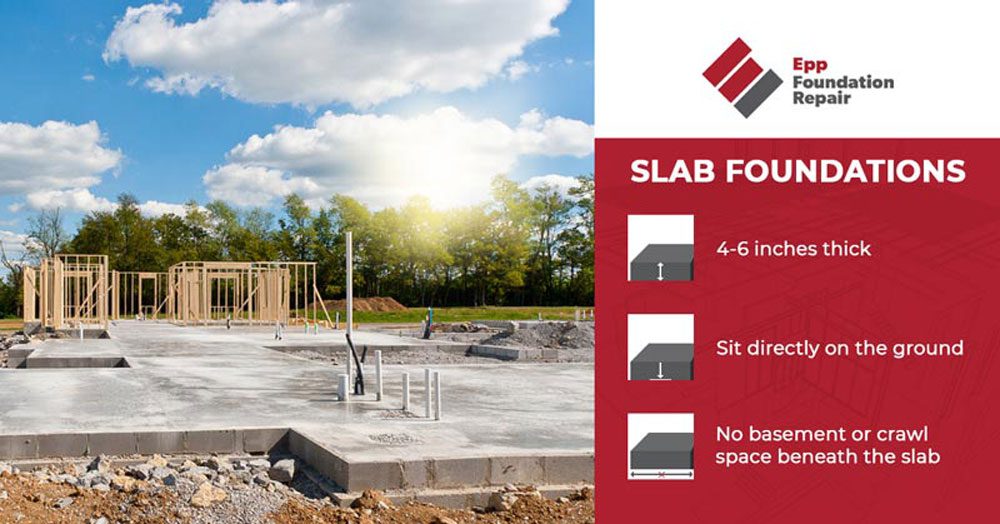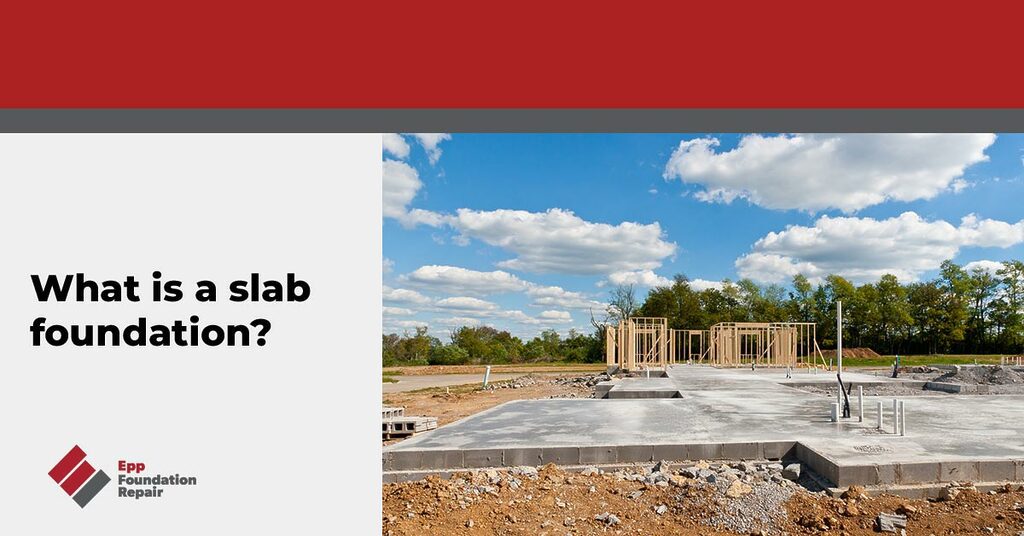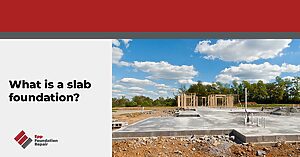A slab foundation is any type of foundation made up of a flat poured concrete surface, usually sitting directly on prepared soil and creating the floor of the structure it supports.
Slab foundations are durable and have a life expectancy of 80 to 100 years or more when properly built and maintained. That being said, there are many different types of slab foundations to suit homeowners’ various financial and geographic needs.
What Are the 5 Main Types of Slab Foundations?
1. Monolithic (On-Grade) Foundation
Monolithic slabs are amongst the most common, simplest, and affordable types of slab foundations. They consist of a single layer of concrete, about four to six inches thick, poured directly onto prepared soil.
First, a builder will compact the soil and possibly add materials like sand or gravel to improve water drainage. Then, wood framing is set up to guide the concrete when it is poured. Along the perimeter and where load-bearing walls will go, the concrete is thicker (about 12 to 24 inches) to support the weight of the building. When the concrete is poured, footers are made at the corners to create one solid foundation.
2. Stem Wall (Raised) Foundation
A stem wall foundation consists of a concrete slab on top of a concrete wall and footings. These raised foundations are popular in areas prone to flooding because they raise the home above the ground.
First, concrete footers are placed below the prepared soil. A partially submerged wall is then made to create the perimeter and support load-bearing walls. This wall may be made of masonry blocks or poured concrete. The space between the walls will usually be filled with compacted soil. Then, a slab of concrete is poured over the top to create the floor of the building.
3. T-Shaped Foundation
T-shaped foundations are used in frost-prone regions. They are a type of stem-wall foundation known for their inverted T-shaped footers that penetrate below the soil’s frost line.
4. Frost-Protected Foundation
As the name suggests, frost-protected foundations protect homes from frost heave. Polystyrene sheets around the edges and base of the slab insulate the foundation, protecting it when the ground freezes. These foundations require less digging than T-shaped foundations since the footings do not have to go past the soil’s frost line. They are shallower and easier to construct.
5. Floating Foundation
Floating foundations are generally used for small structures, like sheds. They generally consist of a single slab that may or may not sit on a detached concrete footing, hence why they are considered floating.
To learn more, see monolithic and stem wall foundations.
Advantages of Slab Foundations
- Cheaper Initial Cost
Slab foundations are usually cheaper than basement and crawl space foundations since they require less excavation and materials. - Faster Build Time
Slab foundations are usually easier and quicker to build since they require less excavation and may be completed in a single concrete pour. - Low Maintenance
Concrete slab foundations require little to no maintenance since they are solid masses that are less susceptible to issues like moisture damage, infestations, and even radon gas leaks. The main thing to watch for is cracks and ensuring you protect your home from excessive moisture in the soil and extensive root systems. - Protection from Pests
Slab foundations do not have space beneath the home, preventing insects and animals from building nests. There is also no exposed wood or moisture to attract them. - Durability
Concrete foundations have a high weight-bearing capacity, making them an ideal foundation choice.

Disadvantages of slab foundations
- Difficulty Accessing Water and Gas Lines
In homes with slab foundations, gas and water lines are embedded in the concrete foundation. If they ever need repairs, the concrete needs to be jackhammered to access them, raising the cost of repairs. - Prone to Freezing Damage
Even with advances in building techniques, concrete is still prone to cracking in areas with extremely low temperatures. Such cracks can increase the chance of moisture-related issues and put your home’s structural integrity at risk. - Poor Insulation
Slabs do not require insulation, which may reduce your home’s energy efficiency in winter. You may notice that your floors will be colder and have higher heating costs.
When Is a Slab Foundation Best?
Slab foundations are ideal in the following situations:
- Temperate climates: Since they are prone to cracking in areas subject to freezing, slab foundations are best in areas that do not have a frost line.
- Minimize construction and maintenance costs: If time and money are significant factors for your build, you may lean towards a slab foundation.
- Shallow Bedrock & High Water Table: If your land makes digging difficult, either because it is too rocky or the water table is near the surface, consider a slab foundation.
- Flat Ground: Concrete slabs need leveled ground since they are one solid piece. A slab foundation is a good choice if your land is already leveled.
- Accessibility Needs: If steps are challenging, consider a slab foundation, which is generally flush with the ground.
For more information, see Slab Foundation Vs. Crawl Space.
Common Problems With Slab Foundations
No foundation is indestructible. The most common issues for concrete slabs are cracking, differential settlement, and upheaval.
- Cracking
A slab may crack because of large tree roots, freezing temperatures, earthquakes, and shifting soil. Cracking can affect the structural integrity of your home and should be examined by a professional foundation repair contractor. - Differential Settlement
While it is normal for a home to settle, or sink, slightly into the ground, differential settlement is when part of your home settles faster than the rest. This may happen because of issues with the soil, like excessive moisture or erosion. Differential settlement is a structural issue. It also leads to problems like sagging ceilings, cracks in the foundation, floor, and walls, and warped framing, causing doors and windows to stick. - Upheaval
When the moisture in the soil freezes, it can cause the slab to rise and become uneven. Upheaval leads to similar issues as differential settlement.
Common Repairs for Slab Foundations
Common repairs for slab foundations include leveling uneven slabs with a method called foundation underpinning and sealing cracks with unique solutions such as epoxy injections.
Foundation Underpinning
With the help of push and helical piers, your home’s foundation can be leveled permanently by connecting it to stable ground below and raising it as much as possible without causing damage.
Epoxy Injections
This special sealant is waterproof and reinforces the concrete while patching cracks.
If your concrete slab foundation is experiencing any cracking, differential settlement, or upheaval, contact us as soon as possible to provide the best solution. With 30 years of experience, we can help you permanently restore the safety and integrity of your home. We service areas in Nebraska, Iowa, Kansas, and Missouri.







